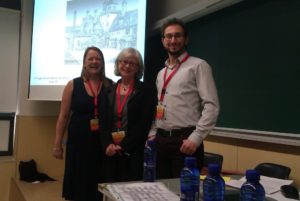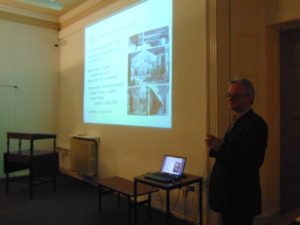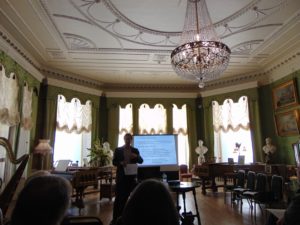
Last month I spent some time travelling and giving talks about our project, and was very encouraged by the positive feedback we received. It began with a talk at the end of March in Valencia at the European Social Science History Conference, given as part of a panel on energy use in the countryside. As a historian of science and technology I must admit that this was not a conference which would otherwise have appeared on my radar, being very general in scope, but it was for precisely this reason that it afforded Abigail Harrison-Moore and me the opportunity to reach out and engage a broader cross-section of the wider historical community with our project.
At a conference of that size you don’t expect large audiences for any one session, but we were very pleased with the level of engagement with our topic, and the thoughtful comments and discussion which followed the panel. Although there were only a handful of historians of technology at the conference, the attendance at our session and the conversations which have come out of our meetings with other scholars have demonstrated to us the unexpectedly large degree to which other people are working on questions related to ours within their own respective historical disciplines. Although as historians I feel we tend to fracture quite easily into insular sub-groups – historians of STEM, economic historians, art historians, environmental historians… – I would certainly recommend attendance at broader conferences such as the ESSHC as a means of reaching out beyond our own disciplinary communities.

I then delivered our Cragside, Standen and Lotherton Hall public lectures. The first of these, focusing on Cragside, was given jointly with Graeme Gooday at the Newcastle Literary and Philosophical Society, the very venue were Swan first presented his lightbulb in February 1879 – noted by one attendee in their feedback: “It was great to have this here where Swan first demonstrated.” The turn-out was excellent – nearly 70 people – and our double-act was very effective: we shared out the material such that Professor Gooday covered the more general sweep of the narrative, and I focused in on developments at Cragside where they were key to the story. This switching between speakers ensured we maintained a good pace, as well as the interest of the audience!
My talk at Standen gave me the opportunity to discuss our work with many of the volunteers who work in the house. For this I used the videos filmed for the Standen section of our online interactive resource in order to structure the talk, leading the audience on a virtual tour around some of the key rooms of the house and expanding upon the themes raised in the video clips. When asked in our feedback form how the content of the talk would affect their work in the house and their interactions with visitors, many volunteers gave very positive responses such as:
- “Can place Standen’s illuminations in a historical setting”
- “The visitors are fascinated that electricity was in Standen from the beginning. It will help me to give them correct information”
- “I’ll talk much better about early electricity than I was able to do before”
- “I have learned a lot more about electricity in the house. The visitors are always interested in the electricity”
- “Will enable room guides to better answer visitors’ questions. Some visitors want to discuss early electricity in great detail.”

For each talk, we asked attendees to tell us the most interesting thing they had learnt. One of the most common responses to this question was the role of women in the story of the uptake of domestic electricity. Some respondents noted the importance of women in promoting the acceptance of the new technology as something of which they had been unaware; for others it was the concerns of women regarding the brightness of electric lighting compared to softer gas, oil or candle lighting which was most interesting.
Encouragingly, one attendee at the Newcastle talk, in answer to the question “To what extent do you agree that this evening’s talk was accessible and understandable?” (strongly agree, agree, etc), responded “Strongly agree. Definitely thought beforehand it may not be.” So I’m glad we managed to meet and go beyond expectations there! Another noted the “irony of sitting in the dark for an illuminating talk on lighting!”
My next and final such public lecture of the project will be at Nostell Priory, a National Trust property near Wakefield, close to Leeds, on Sunday 19 June; please check the events page for more details.